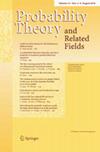Stationary local random countable sets over the Wiener noise
IF 1.6
1区 数学
Q2 STATISTICS & PROBABILITY
引用次数: 0
Abstract
Abstract The times of Brownian local minima, maxima and their union are three distinct examples of local, stationary, dense, random countable sets associated with classical Wiener noise. Being local means, roughly, determined by the local behavior of the sample paths of the Brownian motion, and stationary means invariant relative to the Lévy shifts of the sample paths. We answer to the affirmative Tsirelson’s question, whether or not there are any others, and develop some general theory for such sets. An extra ingredient to their structure, that of an honest indexation, leads to a splitting result that is akin to the Wiener–Hopf factorization of the Brownian motion at the minimum (or maximum) and has the latter as a special case. Sets admitting an honest indexation are moreover shown to have the property that no stopping time belongs to them with positive probability. They are also minimal: they do not have any non-empty proper local stationary subsets. Random sets, of the kind studied in this paper, honestly indexed or otherwise, give rise to nonclassical one-dimensional noises, generalizing the noise of splitting. Some properties of these noises and the inter-relations between them are investigated. In particular, subsets are connected to subnoises.维纳噪声上的平稳局部随机可数集
布朗局部极小值、极大值及其并集的时间是与经典维纳噪声相关的局部、平稳、密集、随机可数集的三个不同的例子。局部是指,大致上,由布朗运动的样本路径的局部行为决定,平稳是指相对于样本路径的lsamvy位移是不变的。我们回答了肯定的Tsirelson的问题,是否有任何其他的,并发展了一些关于这样的集合的一般理论。它们结构的一个额外成分,即诚实指数化,导致分裂结果类似于最小(或最大)布朗运动的维纳-霍普夫分解,并将后者作为特殊情况。此外,还证明了允许诚实索引的集合具有不存在停止时间的正概率性质。它们也是极小的:它们没有任何非空的适当的局部平稳子集。本文所研究的这种随机集,无论是否被诚实地索引,都会产生非经典的一维噪声,从而推广了分裂噪声。研究了这些噪声的一些性质以及它们之间的相互关系。特别是,子集与子噪声相连接。
本文章由计算机程序翻译,如有差异,请以英文原文为准。
求助全文
约1分钟内获得全文
求助全文
来源期刊

Probability Theory and Related Fields
数学-统计学与概率论
CiteScore
3.70
自引率
5.00%
发文量
71
审稿时长
6-12 weeks
期刊介绍:
Probability Theory and Related Fields publishes research papers in modern probability theory and its various fields of application. Thus, subjects of interest include: mathematical statistical physics, mathematical statistics, mathematical biology, theoretical computer science, and applications of probability theory to other areas of mathematics such as combinatorics, analysis, ergodic theory and geometry. Survey papers on emerging areas of importance may be considered for publication. The main languages of publication are English, French and German.
 求助内容:
求助内容: 应助结果提醒方式:
应助结果提醒方式:


